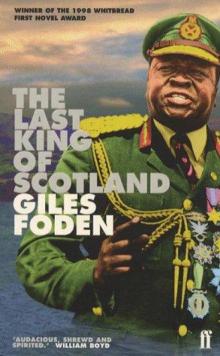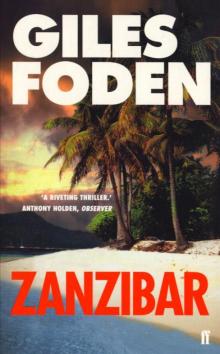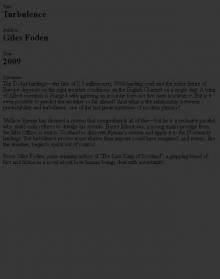- Home
- Giles Foden
2004 - Mimi and Toutou Go Forth Page 17
2004 - Mimi and Toutou Go Forth Read online
Page 17
The shots missed, but Odebrecht knew he was in trouble. His stern-mounted Hotchkiss machine-gun did not have the range of the three-pounder on Mimi. The German swung Hedwig round and let fly with his forward-mounted six-pounders. Proper artillery that could do proper damage, they fired high explosive.
‘Turn to the right!’ Wainwright the land-crab shouted to Mollison as the two shells sped through the air. ‘Over to the right!’ (He should have said ‘starboard’ but of course he wasn’t a seaman.)
Mollison manoeuvred the boat out of the way of the falling shells—which flashed as they hit the water—and seconds later Mimi was firing again at the Hedwig from the side. Once again Odebrecht swung round, to give his front-mounted guns purchase. The two boats circled each other in this fashion for half an hour, neither inflicting significant damage.
Meanwhile Fundi’s hard work down in the engine-room was paying off. Fifi was gaining again. On deck, Waterhouse fired shell after shell from her big gun. On Mimi, Wainwright, who was close to where they were falling, could see they were missing the target. He called off his own attack on the Hedwig and circled back to tell Spicer that the range was wrong. He was greeted, says Shankland, by a storm of abuse from Spicer and more frantic semaphore: ‘When Spicer paused for breath, Wainwright shouted back in his piercing high-pitched Belfast voice, ‘No use signalling to me, Captain. We can’t read you or make any signals in reply. The Hedwig’s in easy range now. All your shots are going a long way over.’’
Spicer had only three rounds left. Waterhouse had shot off nearly all the ammunition. If the Hedwig turned again now, Fifi would be at her mercy. If Fifi could hit the Hedwig with one of the three remaining rounds, she might just save the day. Spicer almost called off the action, but decided to try his luck.
He gave the order to fire and Waterhouse pulled the trigger, steadying himself for the twelve-pounder’s resounding boom. Nothing happened. It was a misfire. They had to wait 20 minutes before the hot shell could be removed from the breech and dumped over the side. Spicer and the others could only watch as the Hedwig pulled away.
When the British stopped firing, Odebrecht realised he had a chance. They were now nearing the rendezvous point with Zimmer on the Götzen, which would blow the British away. He lifted his binoculars and scanned the horizon, looking for the familiar massive shape of the symbol German dominance on the lake. It was nowhere to be seen.
While Odebrecht was looking for the Götzen, another shell was prepared on Fifi. Waterhouse took careful aim this time and fired. A hit at last! It smashed through the Hedwig’s hull. Water started pouring into the ship as, almost immediately, another shell landed, exploding in the Hedwig’s engine-room and bursting the boiler. Five African crew members and two Germans were killed. A seaman named Kasemann had his hand shattered by the splinters. As steam poured out, the oily logs that had been piled up caught fire.
Overwhelmed by fatigue and frustration, Odebrecht realised the game was up. He gave orders to abandon ship. The crew donned life-vests and leapt overboard. Some tried to launch the steamer’s lighter, but there were too many of them and it sank under their weight.
Odebrecht and an engineer called Mewes were the last to leave the Hedwig, which was now enveloped in smoke and flames. Before abandoning ship they set explosive charges to destroy her, so that she could not be captured by the enemy. They jumped overboard as the ship began to list and as they were swimming away the charges exploded. Bow first, the Hedwig slipped beneath the waves.
When the Allied flotilla reached the place where she went down, pieces of wreckage and cargo were coming to the surface among the bobbing heads of survivors. Mimi and Fifi picked up the remaining German crew, and as they did so, Spicer spotted a flag locker among the flotsam. He at once put Fifi about to pick it up.
Opening it, he was delighted to find a large German naval ensign—the first to be captured intact in the whole war.
It was afternoon by the time the victorious flotilla arrived back at Albertville with its prisoners. Stepping ashore, Spicer received a hero’s welcome. Stinghlamber and the other Belgian officers kissed and embraced him. The Holo-holo crowding the bluff—over a thousand in number now roared their approval and streamed down to engulf him. As the prisoners were lined up on the breakwater and handed over to the Belgians and their askaris, only Spicer’s sun-helmet could be seen as he was mobbed by the ululating men and women. This time handfuls of sand were sprinkled over his head—to signify, says Shankland, ‘the land is thine!’
‘The wives of the chief came to greet me as I landed,’ recalled Spicer. ‘Their message of saluting is rather uncomfortable. The idea is to pick up a handful of earth and present it to you…but when, as in this case, they pick up handfuls of gravel and throw them at you it is not so pleasant.’
The Belgians were elevated by association. When they had first arrived at the lake, the Africans had called them Bula Matari (‘omnipotent force’), but this practice ceased when the Belgians began to lose to the Germans. Now they had a fighting chance of being Bula Matari again.
Standing on the breakwater beside Kasemann, a despondent Leutnant Odebrecht watched the rejoicing crowds. He felt weak with fatigue and had lost most of his clothes; he’d had to strip off in the lake to swim and was now wearing only socks and trousers. But Kasemann, cradling his bleeding hand, was in worse shape. Realising the seaman needed urgent attention, Odebrecht spoke to one of their Belgian guards. He and Kasemann were marched off to see a man who introduced himself as ‘Der Herr Doktor hier ‘.
Dr Hanschell decided an operation was necessary. Kasemann was taken to the large hospital hut in the new camp, where ‘Tubby’ Eastwood administered chloroform. Odebrecht stood by to comfort him, until the cotton pad over Kasemann’s mouth took effect and he lost consciousness. As Rupia held down Kasemann’s arm, the doctor amputated two and a half fingers.
While Kasemann slept off the anaesthetic, Dr Hanschell noticed that Odebrecht was exhausted and gave him a glass of hospital brandy. As Odebrecht drank, he signed his parole, which had been brought in during the amputation. It was a promise not to escape, in return for which he would, as an officer and a gentleman, be accorded certain privileges.
One of these was an invitation from Spicer to dine in the British mess, which Odebrecht accepted, subject to shoes and a shirt being found for him. There being no spare shoes in the camp, Dr Hanschell had to give him his long, brown-leather mosquito boots (‘it hurt him to the heart to part with them,’ notes Shankland). According to Magee, Odebrecht put on an Iron Cross medal for dinner, in which case he must have kept the precious decoration in his pocket or held it when he jumped off the Hedwig.
It was dark by now, but the Holo-holo were still celebrating up in the hills, beating drums in the firelight. As Odebrecht followed Dr Hanschell over to the mess-hut, he saw the silhouettes of dancing figures, swaying and quivering in the firesmoke. Inside the hut, he was introduced to Spicer. The British commander’s short-sleeved shirt revealed arms covered with writhing tattoos. Odebrecht brought sharply together the heels of the doctor’s mosquito boots and gave a stiff bow. Spicer bowed in return and they sat down to eat.
It was a strange meal. Barely a word was spoken, even by Spicer, and the only sound was the rush of the insect-besieged kerosene lamps and the revellers outside. Like the Holo-holo, the lower British ranks were celebrating enthusiastically. Fuelled by some wine the Belgians had sent over, they were singing anti-German songs around a bonfire. Back in the mess-hut, Spicer’s servant Tom served the officers tinned soup, beef stew and coffee. There was also some broiled catfish: it was supposed to be an entree, but came too late. As Dr Hanschell recalled: ‘Tom, gazing with awe at the snakes on Spicer’s arms and forgetting to serve the fish, was sharply recalled to his duties by a jab in the stomach from Spicer’s fork.’
Despite this delay, dinner lasted a mere 20 minutes, upon which Spicer rose, nodded goodnight to Odebrecht, and disappeared into his tent. The other officers soon followed his
example. It was left to Dr Hanschell to escort Odebrecht back to the hospital hut. The German complained of a bad headache, so the doctor administered a sedative injection. Within a few minutes the exhausted Odebrecht was asleep, relieved for a while of the terrible burden of defeat.
So ended the second battle of Lake Tanganyika. While Odebrecht slept, Spicer was busy writing up his report to the Admiralty. It had been a great success, he said, describing it as ‘a naval action in miniature’. He even claimed to have ordered Wainwright forward in Mimi (rather than telling him to get back in line) and praised the Belfast man for following his orders. The news was well received, once the Morse had been transcribed back at Admiralty House. In his notes on Spicer’s report, the First Sea Lord Sir Henry Jackson wrote: ‘I doubt whether any one tactical operation of such miniature proportions has exercised so important an influence on enemy operations.’ Now the joint Belgian-British advance across the lake could begin.
What the Admiral didn’t know was that a few days after Spicer had made practice runs in Mimi and Toutou on the Thames in June 1915, the German supership the Graf von Götzen had been launched on Lake Tanganyika. Spicer was all too aware of the fearsome Götzen and he knew it made a mockery of his toy navy. But the Admiralty was still in the dark about the mighty German warship.
TWENTY
The morning after the victory meal saw Odebrecht much rested. The morphine in Hanschell’s injection had worked its magic. Kasemann, too, was doing well. Over breakfast with Dr Hanschell, Odebrecht seemed to have come to terms with the sinking of the Hedwig, but there was one thing that worried him: the strange pattern of the battle led him to believe that he had been bested by a bunch of amateurs. Spicer’s skirt and tattoos had only reinforced this impression. So the German was much relieved when the doctor told him that despite appearances Spicer was a trained naval officer.
This allowed Odebrecht to give purely technical reasons for his defeat. In their paper, Bishop and Dobold refer to a letter Odebrecht sent to Otto Schloifer, the man who had built the Hedwig on the lakeshore in 1900. Odebrecht ‘justified his defeat by stating that he simply ran into a superior enemy force consisting of four vessels which were superior in speed and armament and which opened fire from a distance of 8,000 metres, while his own guns had maximum ranges of only 3,000m and 2,500m respectively’.
Schloifer wasn’t the only shipbuilder for the German naval forces in Africa. In 1913 a German shipyard run by Joseph Meyer had received an important new contract. Meyer, whose yard was at Papenburg on the Ems River, was commissioned to build a twin-screw cargo and passenger ship of 1,200 tons, with a draught of four metres. The proposed vessel—about two-thirds the length of a football pitch—was due for service on Lake Tanganyika.
Mimi and Toutou were tiny by comparison. And with their wooden hulls made on the Thames, they were far less sturdy than the steel-plated monster constructed on the Ems. The British boats were at the tail-end of a marine-craft tradition in wood; the German ship was a modern industrial product, riveted together—in some haste, admittedly, because Meyer and his team had less than a year in which to complete the contract.
The new German ship was to be called the Graf von Götzen after the colony’s former military governor, Count Adolf von Götzen. It was the largest order that had ever come into the Papenburg shipyard, where the Meyer family had been building boats for generations. They asked for payment in five instalments, the first payable immediately and the last on delivery of the ship to the port of Hamburg. The total cost was 406,000 Deutschmarks, the equivalent of about £20,000 in those days.
The order had been placed at the instigation of none other than Kaiser Wilhelm II himself, following information received from his government surveyor in 1910. The surveyor’s agents in East Africa had pointed out that the Belgians had only smallish craft on Lake Tanganyika and the British just a few tramp steamers on Lake Victoria and Lake Nyasa. A proper ship on one of the great African inland seas would be a considerable commercial asset to Germany and an important factor in the balance of power in the territory.
Purchased through the Kaiser’s East African Railway Company, the Götzen was not originally envisaged as a troopship, but as a commercial venture with military possibilities. The likely advent of war with Britain changed all that, however. By the time the order was sent to the Meyer shipyard in January 1913, the Kaiser and his advisers knew the Götzen might be used to carry troops. The pressures of the approaching war are evident in a telegram sent eleven months later by Dr Heinrich Schnee, Götzen’s successor as Governor of German East Africa:
Accelerate by all means sending slips, shipyard equipment, for Götzen with the latest mounting instruments. Send with 20 skilled ship-builders, if possible employees of the Railway. Economic interests and prestige demand urgency.
At Papenburg, work on the Götzen went on apace, even though the yard’s owners and workers were pretty much in the dark as to the Government’s plans for the ship. The order stated it had to be built so that it could be transported to an inland lake and that was all the information they had to go on.
‘They knew that the ship had to get there by land somehow,’ recalled Hermann Wendt, when interviewed for a German television documentary broadcast in 2001. His father (also called Hermann) had been a shipwright in the Meyer yard and had worked on the Götzen. ‘After a lot of thinking about the best way to do it, they built the ship in Papenburg, but all the parts were just screwed together. Everything was only provisionally fixed.’
Hermann Wendt senior, along with two other shipwrights from Meyer’s—Anton Ruter and Rudolf Tellmann—were requested to deliver the Götzen in person to the shores of Lake Tanganyika. It was proposed that the ship be broken down into its constituent parts for transport and that the shipwrights would reassemble it in Africa. They were to be well paid for their work, and as Wendt’s son observed: ‘They went away to become rich. The three of them wanted to make money.’
The shipwrights’ contracts of employment provided for large cash bonuses if the operation was successful and it is no coincidence that they were signed in early November 1913, the period of phony engagement, a little over nine months before the start of the First World War. The two great powers, Germany and Britain, were already in a breathless arms race in which naval power was a key factor. The Graf von Götzen would be a crucial part of the German war machine.
By the end of November, the loose-bolted ship was ready. Her wood-burning steam engine was fired up to see if it worked properly. Then the steel pieces of the hull and superstructure were unscrewed and taken apart. In total, the ship broke down into hundreds of thousands of individual pieces, each of which was given a code number. Packed in 5,000 numbered crates, they were sent by train to Hamburg and loaded aboard four freighters.
On 19 December 1913 the cargo ships Admiral and Feldmarschall left Hamburg for Dar es Salaam, German East Africa. They carried the hull, bulkheads, deck pillars and beams for the reconstruction of the Götzen in Africa—and the scaffolding upon which this would take place, once it had been erected in Kigoma harbour on the lake. They also carried all of the rivets, which on a project this size amounted to a considerable cargo in itself.
The chronology was sensible, the planning exact. This first consignment of newly forged steel would include ‘all the pieces necessary to set the ship in ribs’, according to a letter from the East African Company’s Berlin HQ to Dar es Salaam. The freighters Windhoek and Adolf Woermann left Hamburg early in the new year, carrying further cargoes. In the Windhoek were stowed the masts, boilers and engine. The third consignment, on the Adolf Woermann, consisted of all the interior fittings: the panelling for the cabins, the installations and furniture. It also carried the deck houses and the upper works—the capstans, winches and cranes—as well as the lifeboats and funnels.
Despite war being in the air, indeed being actively prepared for by Britain and Germany, all these parts and equipment were insured by British companies. At a premium of a half per cen
t for a total insurance of £25,000, twelve British companies around the world participated in the risk. Lloyds of London shouldered the bulk of it, taking on £8,500. The rest was spread out between different companies in chunks of less than £2,000. That was the figure for which the Canton Insurance Office and the firm of British Dominions were responsible. The Thames and Mersey Marine Insurance Company took on £1,000. The New Zealand Insurance Company took on £500. Their policies covered ‘all risks including fire, while under construction and⁄or fitting out…Also all risks of trial trips.’
At a total cost of £125 to the Germans in premiums, it must have seemed like a good deal. But Lloyds and its associates took no chances. The policies were also issued on the basis that the Götzen was ‘warranted free of capture, seizure and detention, and the consequences thereof or any attempt thereat, piracy excepted, and also from all consequences of hostilities or warlike operations whether before or after declaration of war’.
After a journey that had taken in the Mediterranean, the Suez Canal and the Indian Ocean, the shipwrights Wendt, Ruter and Tellmann arrived in Dar es Salaam in early 1914. German East Africa was a world away from Papenburg—a world about to be shaken to its core. In under six months war would be declared. Dar es Salaam means ‘Haven of Peace’ in Arabic. By the time the War was over, the three shipwrights would appreciate the irony of this. For the time being, they supervised the unloading and warehousing of the 5,000 crates containing the Götzen.
They also acclimatised to being in Africa. ‘At first they were scared,’ Rudolf Tellmann’s daughter explained in the 2001 documentary. ‘They came from here [Germany] and hadn’t been anywhere else in their lives, and suddenly they were surrounded by Africans. They were frightened. Later, though, my father said blacks were willing people, they would have done anything for them.’

 The Last King of Scotland (1998)
The Last King of Scotland (1998) Zanzibar
Zanzibar Turbulence
Turbulence The Last King of Scotland
The Last King of Scotland 1999 - Ladysmith
1999 - Ladysmith 2004 - Mimi and Toutou Go Forth
2004 - Mimi and Toutou Go Forth 2009 - Turbulence
2009 - Turbulence